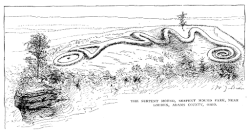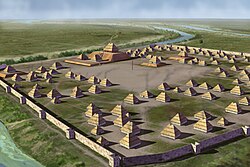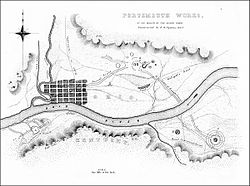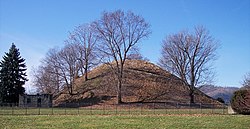Mound builders
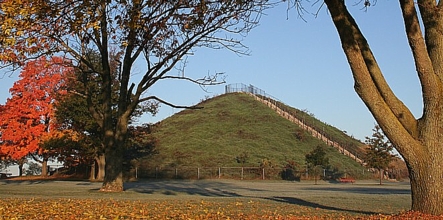
Mound Builder is a general term referring to certain cultures of pre-Columbian American Indians. These cultures built various styles of earthen mounds. There were burial, residential and ceremonial purposes. The cultures cover a long period of time. This is from about 3500 BCE to the 16th century CE. This includes the Archaic, Woodland and Mississippian periods. Notable cultures were the Adena, Hopewell, Plaquemine, Fort Ancient, Coles Creek and Mississippian cultures. These groups were around the Great Lakes, the Ohio River Valley, and the Mississippi River.
The mounds were flat structures with layers. They usually were pyramids. Some mounds were like domes.[1] Some mounds were effigy mounds. They had shapes of animals. One famous one is the Serpent Mound in Ohio.[2] The oldest mound is probably the Watson Brake in Louisiana.[3] Usually, elite made workers build the mounds. Some mounds were burial sites for elite people of the tribes.[1]
There were several records of these mounds. Hernando de Soto was one of the earliest to see and record these mounds. The French artist Jacques le Moyne made paintings of these mounds. All of the mounds today are from the Woodland and Mississippian periods.[1]
The mounds started to disappear with colonization. Disease decreased the population sizes of American Indians. Mound building ended after the 17th century.[1]
Mound Builders Media
Monks Mound, built c. 950–1100 CE and located at the Cahokia Mounds UNESCO World Heritage Site near Collinsville, Illinois, is the largest pre-Columbian earthwork in America north of Mesoamerica.
A mound diagram of the platform mound showing the multiple layers of mound construction, mound structures such as temples or mortuaries, ramps with log stairs, and prior structures under later layers, multiple terraces, and intrusive burials
A depiction of the Serpent Mound in southern Ohio, as published in the magazine The Century, April 1890
Illustration of the Parkin site, thought to be the capital of the province of Casqui visited by de Soto
Engraving after Jacques le Moyne, showing the burial of a Timucua chief
A depiction of the Portsmouth Earthworks in Ancient Monuments of the Mississippi Valley
Illustration of Watson Brake, the oldest known mound complex in North America
Illustration of Poverty Point in West Carroll Parish, Louisiana
Illustration of Kings Crossing site in Warren County, Mississippi
Related pages
References
- ↑ 1.0 1.1 1.2 1.3 "The Mound Builders Essay -- National Register of Historic Places Indian Mounds of Mississippi Travel Itinerary". www.nps.gov. Retrieved 2022-07-30.
- ↑ "Serpent Mound". Ohio History Connection. Retrieved 2022-07-29.
- ↑ Saunders, in Rees and Brown (2010), Archaeology of Louisiana, pp. 69–76


